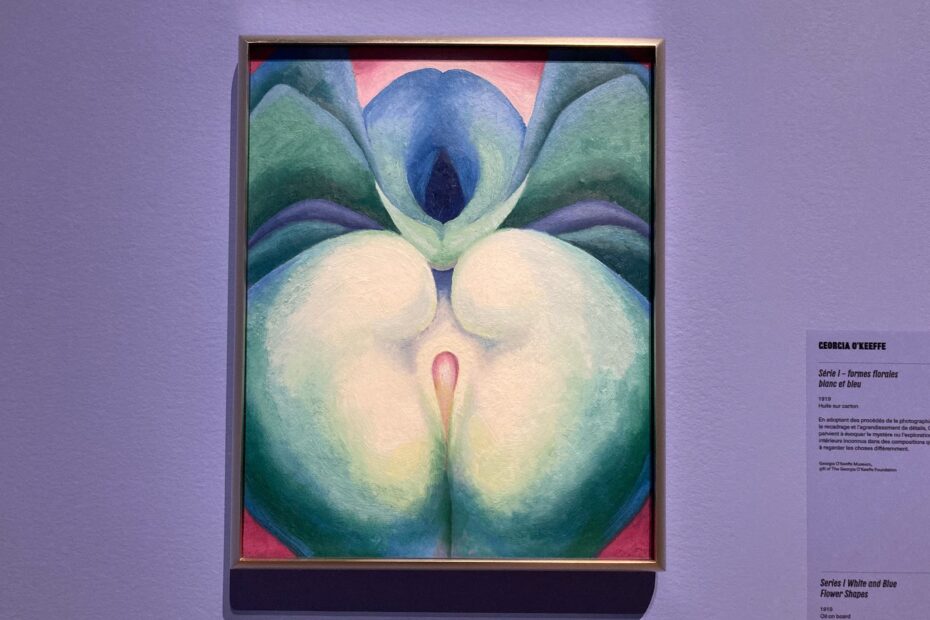It’s unclear whether American painter Georgia O’Keeffe and British sculptor Henry Moore ever met. Their paths crossed at least once, in 1946, when both were present at Moore’s retrospective at the Museum of Modern Art (MoMA) in New York. There is no record, however, of them ever interacting with one another outside of this isolated event.
Yet today, their work has taken up residence in the same halls at the Montreal Museum of Fine Arts (MMFA). Georgia O’Keeffe and Henry Moore: Giants of Modern Art, organized by the San Diego Museum of Art, reveals an obvious dialogue between the two modernists’ oeuvre.
Having both relocated from the busy centers of New York and London to New Mexico and rural Hertfordshire early in their careers, O’Keeffe and Moore became inextricably linked to their respective environments. The MMFA’s exhibition emphasizes the artists’ shared wonder of the natural world, dividing itself into four rooms: bones, stones, shells, and flowers.
The viewer is immediately drawn to O’Keeffe’s famous large-scale paintings of flowers, which are often regarded as erotic. It is easy to see why: her close-up views often border on abstraction, emphasizing shape, form, and color. Series I White & Blue Flower Shapes (1919), an oil on board painting displayed in the first gallery, acutely suggests female genitalia. So much so that during my visit, it left a group of high schoolers spellbound. One of them cleverly pointed out that the painting focuses on the flower’s reproductive organs, so that it is, in a way, sexual. “It does challenge perception and ignite the imagination,” answered their tour guide, who proceeded to lecture the class on how cropping and enlarging a detail — a convention O’Keeffe borrowed from photography — can summon the viewer into an intimate exploration of nature’s intricacies.
The class snapped a few pictures before moving on to Stringed Figures (1938), one of Moore’s lead sculptures. According to the artwork’s didactic, Moore produced about 20 lead works at his countryside cottage, where he experimented with casting lead in his own pots and pans in the late 1930s. Much like O’Keeffe’s flowers, the sculpture possesses an uncanny sensual quality: its smooth curves and surfaces almost invite touch.
Moore was foremost a carver. He made several large elmwood carvings throughout his career, such as Reclining Figure (1959-64), which reflects his growing interest in landscape. The form of the figure follows the grain of the wood while its hollows and overhanging limbs evoke cliffs and caves.
The pair is at their most symbiotic in the bones portion of the exhibition. Here, one can admire O’Keeffe’s paintings by peering through the holes of Moore’s sculptures. Such is the case with Reclining Figure Bone (1975). Carved in travertine marble, the structure resembles an elongated bone — or is it a figure? — that is pierced in two places. It sits on a large table in the middle of the room, putting it in conversation with O’Keeffe’s paintings of pelvic bones, which hang on the wall directly behind it.
Similarly, in Pedernal from the Ranch #1 (1956), O’Keeffe uses a pelvic bone as a window to frame the landscape. Flirting with surrealism, she manipulates scale and perspective by juxtaposing the small object with Pedernal Peak, her favorite mountain in New Mexico. Through her adept use of colour, she conveys the timeless beauty of the Southwestern desert. The use of burnt orange helps capture the desert’s warmth and aridity, while the sky’s shades of blue and lavender clash with the mountain to accentuate its edges.
About halfway through the exhibition, visitors are invited to step into recreations of the artists’ studios, another testament to their shared philosophy. If one wasn’t convinced of their connection, here lies the evidence: feathers, leaves, shells, animal skulls, stones, and pebbles lie here and there on each of their workstations, drawing attention to their shared thematic material.
Both O’Keefe and Moore found magic and beauty in the uncanny. Their captivation with the living world and the various methods they employed to highlight different natural features are so striking that the viewer feels as if they are encountering everyday subjects — flowers, stones, and leaves — for the first time. Moreover, by giving their subjects anthropomorphic qualities, they prompt us to recognize nature’s vitality — to pause and consider our interconnectedness.
Whether or not they ever got to shake hands, O’Keeffe and Moore certainly knew of one another: both were honoured with retrospective exhibitions at the MoMA in 1946, held only a few months apart. It is worth pointing out that both of them also died in the same year — 1986, another bizarre manifestation of their parallel trajectories. The MMFA’s latest exhibition invites Montreal’s museumgoers to reflect on the incredible similarities between Georgia O’Keeffe and Henry Moore’s lives and work, helping cement their status as giants of modern art.
Georgia O’Keeffe and Henry Moore: Giants of Modern Art will be on display at the Montreal Museum of Fine Arts until June 2. For more information, visit the MMFA’s website at www.mbam.qc.ca.

